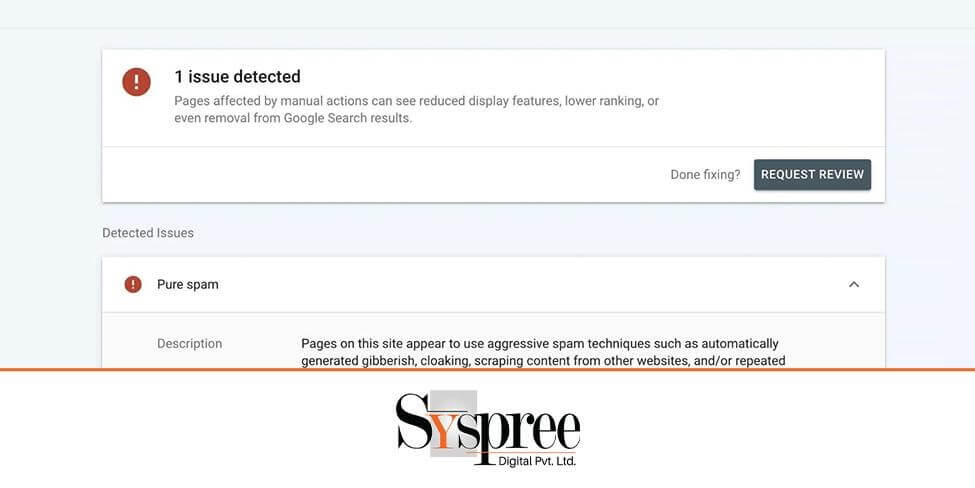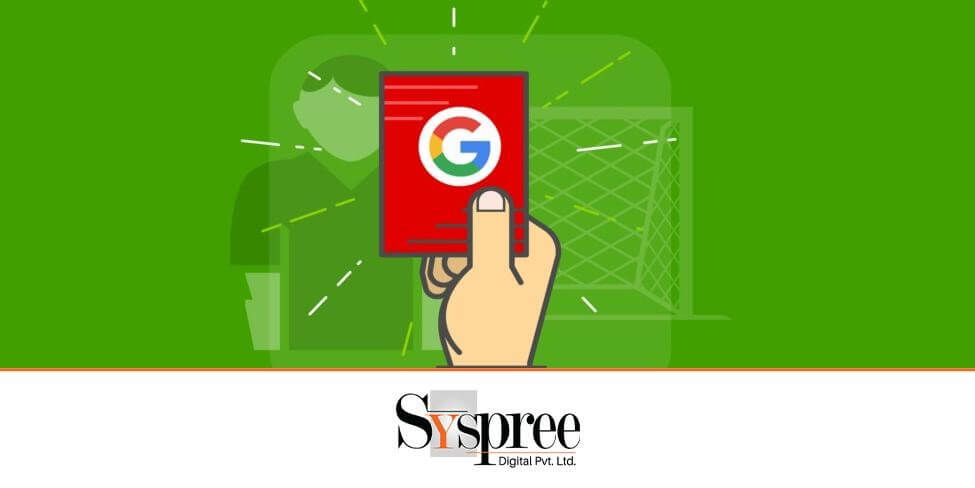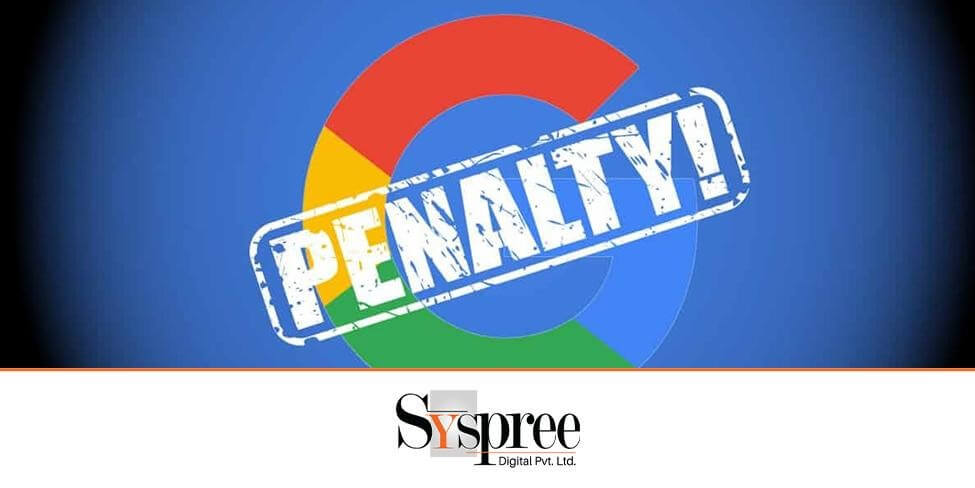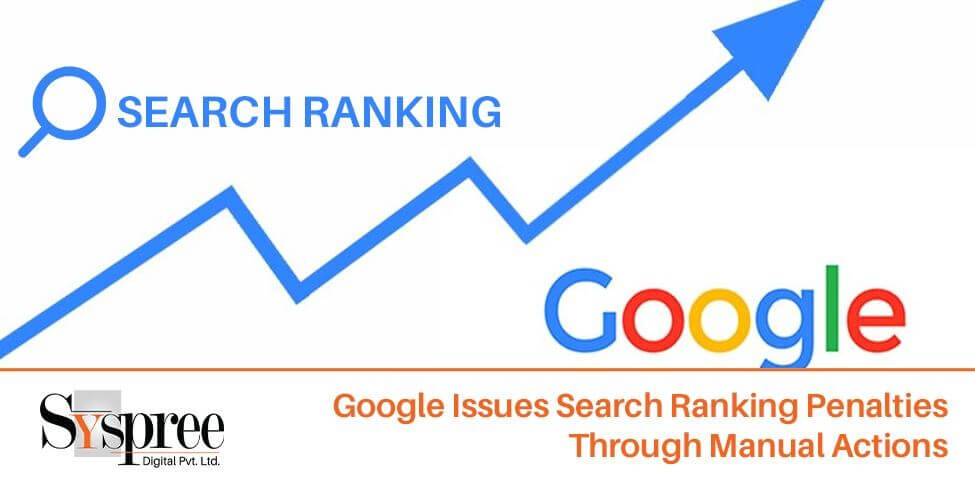Google‘s manual actions of search ranking penalties wield significant influence in the search landscape, dictating the fate of websites based on their compliance with Google’s strict spam policies. Breaching these policies can lead to manual evaluations by Google’s human reviewers, resulting in penalties that range from lowered rankings to complete removal from search results. Common violations include aggressive spam tactics like cloaking and content scraping.
The leading SEO company in Mumbai says the repercussions of these penalties are severe, causing a sudden drop in search visibility and organic traffic. To mitigate the risk of penalties, website owners and SEO professionals must understand and address any infractions promptly, safeguarding their search engine rankings and online presence. Let’s learn more about Google’s harsh penalties and what it could mean to website owners.
Understanding Manual Actions

Search-Ranking-Penalties-–-Understanding-Manual-Actions
Google’s quality control mechanism relies heavily on manual actions to ensure that websites adhere to its guidelines and policies. Unlike algorithmic updates, which are automated adjustments to Google’s search algorithms, manual actions involve direct intervention by human reviewers employed by Google. These reviewers carefully evaluate websites to identify instances of non-compliance with Google’s spam policies and impose penalties when violations are found.
Explanation of Manual Actions and How they Differ from Algorithmic Updates
One important difference between manual actions and algorithmic updates is how they are executed and their scope. Algorithmic updates are applied universally across Google’s search index, affecting search rankings based on algorithmic criteria such as relevance, authority, and user experience. On the other hand, manual actions are targeted interventions aimed at specific websites that are deemed to violate Google’s guidelines. The experts from the leading SEO company in Mumbai say these interventions can range from minor adjustments to a site’s ranking position to more severe penalties, including complete removal from Google’s search results.
The main focus of manual actions is to address websites that engage in manipulative tactics to boost their search rankings or deceive users artificially. Examples of such violations include the use of black hat SEO techniques like keyword stuffing, cloaking, or link schemes, as well as the dissemination of misleading or malicious content. When a website is flagged for violating Google’s spam policies, manual actions are implemented to enforce penalties and uphold the integrity of Google’s search results.
The impact of manual interventions can have a substantial effect on websites that are affected. Websites that receive penalties through manual actions may see a sudden and drastic decrease in search visibility, leading to reduced organic traffic and potentially serious consequences for their online presence and business sustainability. Therefore, it is essential for website owners and SEO professionals to promptly comprehend and rectify manual interventions in order to uphold positive search rankings and minimize the likelihood of being penalized by Google.
Instances of Manual Actions
The best SEO company says Google’s manual actions are a strong deterrent against websites that use manipulative tactics to boost their search rankings. By carefully reviewing websites, Google’s human reviewers can identify and penalize those that violate its spam policies, ensuring the integrity of its search results. Analyzing cases of manual actions provides valuable insights into the consequences of non-compliance and the importance of following Google’s guidelines.
Examination of Specific Cases Where Websites were Penalized by Google for Violating Spam Policies
One common type of manual action is the penalty for pure spam violations. These penalties target websites that use aggressive spam techniques to manipulate search rankings. Examples of such violations include generating gibberish, cloaking, scraping content from other sites, and repeatedly violating Google’s spam policies. Websites guilty of pure spam violations face serious consequences, such as a significant drop in search rankings and potential removal from Google’s search results, effectively making them invisible to users.
Another frequent occurrence of manual actions is penalties for misleading content violations. Websites that deceive users by promising information not found in their content may face manual actions for misleading content. Google identifies these violations through manual reviews and takes corrective action to maintain the trustworthiness and relevance of its search results. Websites penalized for misleading content violations may suffer negative impacts on their search rankings and user trust, resulting in reduced visibility and traffic.
The consequences of manual actions, also known as search ranking penalties, are significant in all cases. Websites that are impacted may experience a sudden and significant decrease in search visibility, leading to reduced organic traffic and potential harm to their reputation and trustworthiness. Moreover, the journey to recover from manual action penalties can be challenging and time-consuming, necessitating dedicated efforts to address violations and seek reconsideration from Google.
Types of Manual Actions
Google utilizes manual actions to uphold its spam policies and uphold the quality and relevance of its search results. Website owners and SEO practitioners must comprehend the different types of manual actions in order to prevent penalties that may harm their search rankings. In this overview, we discuss some prevalent manual actions, such as pure spam and misleading content violations.
1. Pure Spam Violations
Pure spam violations are one of the most severe forms of manual actions that specifically target websites employing aggressive spam tactics to manipulate their search rankings. These tactics involve the utilization of automatically generated content, cloaking, keyword stuffing, and other deceptive practices with the intention of artificially boosting a website’s visibility in search results. The experts from the best SEO company say websites that are found guilty of pure spam violations are subjected to harsh penalties, which may include being delisted from Google’s search results and experiencing significant drops in their search rankings. In order to recover from pure spam penalties, it is crucial to make diligent efforts to rectify the violations and submit a request for reconsideration to Google.
2. Misleading Content Violations

Search Ranking Penalties – Misleading Content Violations
Websites that engage in deceptive practices by making false promises or providing misleading information are subject to manual actions for misleading content violations. These actions are imposed by Google’s human reviewers, who conduct thorough manual reviews to identify such violations. The purpose of these actions is to ensure the trustworthiness and relevance of search results. As a result of these violations, penalized websites may face negative consequences such as lower search rankings, diminished visibility, and decreased user trust, which can ultimately lead to a decline in traffic.
In either scenario, manual actions can lead to search ranking penalties. Websites that are impacted may experience a significant and abrupt decrease in search visibility, leading to reduced organic traffic and potential harm to their reputation and trustworthiness. Website owners and SEO professionals need to follow Google’s guidelines diligently and refrain from using manipulative or deceitful strategies in order to protect their search rankings and minimize the chances of being penalized by Google’s manual actions.
Differentiating Manual Actions and Algorithmic Updates
The leading digital marketing agency in Mumbai says Google utilizes manual actions and algorithmic updates as separate mechanisms to uphold the quality and relevance of its search results, each serving unique functions and functioning through distinct processes.
Human reviewers at Google initiate manual actions, which are interventions aimed at meticulously evaluating websites for violations of Google’s guidelines and spam policies. In cases where a website is found to be in violation, manual actions are enforced, ranging from adjustments to its ranking position to more severe penalties such as de-indexing from Google’s search results. Manual actions can be imposed for various reasons, including pure spam violations or the presence of misleading content, where human judgment plays a vital role in determining adherence to Google’s standards.
Algorithmic Updates
Algorithmic updates refer to automated modifications made to Google’s search algorithms. The primary goal of these updates is to enhance the accuracy and significance of search results by integrating new signals or enhancing current ones. These updates are implemented globally throughout Google’s search index, influencing search rankings for all websites based on algorithmic factors like relevance, authority, and user experience. Notable examples of algorithmic updates consist of major updates such as Google’s core updates, which have the potential to impact search rankings for websites spanning different sectors greatly.
Clarification on the Distinction between Manual Actions Performed by Humans and Automated Algorithmic Updates

Search Ranking Penalties – Algorithmic Updates
The execution and scope of manual actions and algorithmic updates differentiate them. Manual actions require human reviewers to intervene directly and focus on particular websites that violate Google’s guidelines. On the other hand, algorithmic updates are automated adjustments that apply universally to Google’s search index, relying on algorithmic criteria.
Comprehending this distinction is vital for website owners and SEO practitioners to navigate Google’s search ecosystem effectively. While algorithmic updates can affect search rankings for all websites, manual actions specifically address violations of Google’s guidelines and spam policies, potentially resulting in penalties such as search ranking adjustments or removal from search results.
Recovering from Manual Actions
The experts from the leading digital marketing agency in Mumbai say resolving manual action penalties issued by Google is an essential step for website owners aiming to restore their search rankings and online presence. Although the task of recovering from manual actions may appear challenging, adhering to a structured method can facilitate the process efficiently.
- Identify the Manual Action: Begin the process of recovering from a manual action penalty by pinpointing the exact violation identified by Google. Access the Manual Actions section in Google Search Console to find comprehensive details regarding the violation and impacted pages.
- Understand the Violation: It is important to invest time in comprehending the essence of the violation and the reasons behind Google flagging your website. Familiarize yourself with Google’s guidelines and spam policies to understand the actions that resulted in the manual penalty.
- Take Corrective Action: Upon identifying the violation, it is crucial to promptly and decisively address the issue. This could entail removing or updating problematic content, resolving technical issues, or ceasing any practices that go against Google’s guidelines.
- Document Changes: Keep a record of all modifications made to your website in response to the manual action. By documenting the measures taken to rectify the violation, you showcase your dedication to compliance with Google, which can be beneficial when requesting reconsideration.
- Submit a Reconsideration Request: After rectifying the violation on your website and implementing the required changes, proceed to submit a reconsideration request via Google Search Console. When submitting your request, ensure to include a comprehensive explanation of the actions taken to address the violation along with any relevant supporting documents. It is crucial to maintain transparency and openness in your communication with Google.
- Be Patient: Please note that Google’s reconsideration process may require some time. Therefore, it is important to be patient and allow ample time for Google to review your request carefully. Avoid sending your request prematurely, as this may result in further delays in the process.
- Monitor Progress: It is important to closely monitor your website’s performance and search rankings after submitting your reconsideration request. Stay vigilant for any updates from Google regarding the status of your request, and be ready to address any further issues raised by Google’s reviewers.
Impact on Website Owners

Search Ranking Penalties – Impact on Website Owners
Website owners must recognize the importance of regularly checking for manual actions and comprehending the possible repercussions. Google’s manual actions can severely impact a website’s search rankings, visibility, and overall online reputation. Therefore, maintaining a proactive approach to monitoring manual actions is vital to protect the website’s well-being and functionality.
Discussion on the Significance of Checking for Manual Actions and the Potential Consequences of Being Penalized.
Firstly, receiving a manual action penalty can result in a sudden and significant decrease in search rankings. Websites that breach Google’s guidelines may be pushed down to lower positions in search results or, in extreme cases, completely deindexed by Google. This can negatively impact organic traffic, as users are less likely to come across and visit websites that do not show up prominently in search results.
Additionally, the consequences of manual actions go beyond search rankings to affect a website’s overall reputation and credibility. Being penalized by Google can harm trust and credibility with users, indicating to visitors and potential customers that the website may not uphold ethical or quality standards. This loss of trust can lead to lower user engagement, decreased conversions, and even lasting harm to brand reputation.
Conclusion of Google’s Search Ranking Penalties
Google’s search ranking penalties have a substantial impact on websites, affecting their search rankings and credibility online. It is essential for website owners to consistently monitor for manual penalties, as they can result in significant decreases in search visibility and harm to reputation. Following Google’s rules and promptly rectifying any violations is crucial for sustaining search rankings and safeguarding online presence. If you like this blog check out our previous blog The Art of Maximalism in Graphic Design







